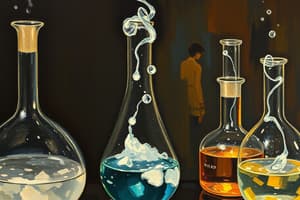Podcast
Questions and Answers
What method is used to separate solids from liquids?
What method is used to separate solids from liquids?
- Distillation
- Filtration (correct)
- Crystallization
- Sublimation
Which technique involves changing a substance from solid to gas?
Which technique involves changing a substance from solid to gas?
- Sublimation (correct)
- Filtration
- Crystallization
- Distillation
Which method is based on the difference in boiling points?
Which method is based on the difference in boiling points?
- Crystallization
- Distillation (correct)
- Filtration
- Extraction
What is the technique called when pouring a mixture onto a membrane to separate solids from liquids?
What is the technique called when pouring a mixture onto a membrane to separate solids from liquids?
Which type of filtration uses a pump to create a pressure difference?
Which type of filtration uses a pump to create a pressure difference?
Study Notes
Organic Chemistry Practical
Sublimation
- Sublimation is a method of separation that involves the transition of a substance from a solid to a gas state.
Methods Based on Physical Properties
- Five methods are used to separate mixtures based on their physical properties:
Filtration
- Filtration is a technique used to separate solids from liquids.
- It involves pouring a mixture onto a membrane (filter paper) that allows the passage of liquid (the filtrate) and results in the collection of the solid.
- Two types of filtration techniques are used in chemical separations:
Filtration Techniques
- Gravity filtration: used to separate an insoluble solid from a liquid when the solid is suspended throughout the liquid.
- Suction filtration: an alternative to gravity filtration.
Note
- A solid/liquid mixture is called a suspension.
Studying That Suits You
Use AI to generate personalized quizzes and flashcards to suit your learning preferences.
Description
Explore the methods of separation based on physical properties in organic chemistry, including filtration, sublimation, crystallization, distillation, and extraction.




